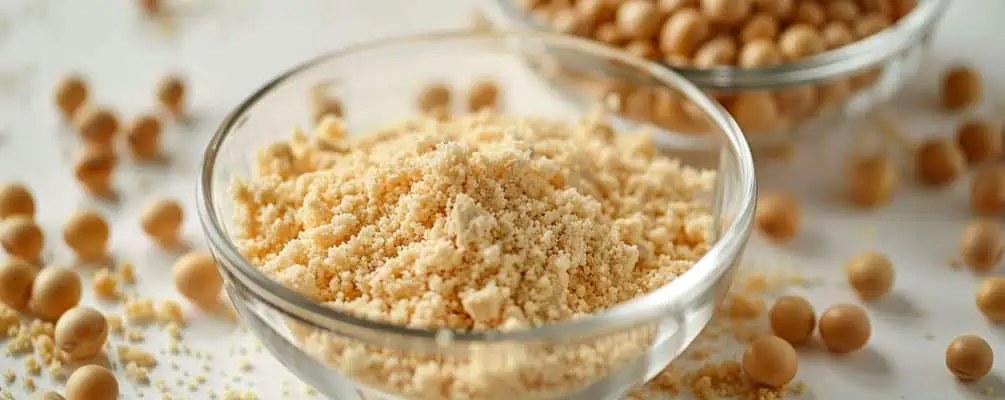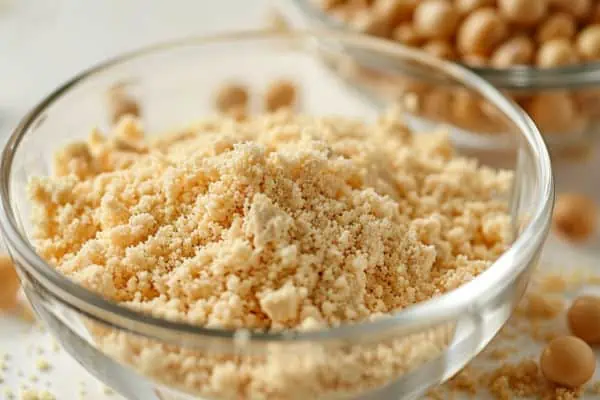What do tofu, soy milk, and soy veggie burgers have in common? They’re all made from those small but mighty soybeans. The process of grinding up soybeans and extracting soy milk also leaves behind a delicious and versatile byproduct – the fiber-rich pulp known as okara or soybean pulp.
Though it was once thrown out as waste, innovative cooks have discovered that this mildly flavored nutrient-dense soy pulp can be used in all types of cooking and baking recipes as a protein and fiber boost. Keep reading to learn all about soy pulp, how it’s produced, and our favorite ways to use it!

Where Soybean Pulp (Okara) Comes from?
Soybean pulp, also referred to as okara in Japanese term, is the fiber byproduct left over after producing soy milk or tofu from whole soybeans. To make soy milk or tofu, whole soybeans are first soaked and then ground or blended along with water to create a soybean slurry. This releases the proteins, fats, carbohydrates, and other soluble components into the water. The mixture is then strained or pressed to separate the insoluble fiber pulp from the soy liquid.
The strained soy liquid is what goes on to be boiled, coagulated, and processed into final soy products like soy milk and tofu. Meanwhile, the strained fiber residue leftover from this separation process is known as soybean pulp or okara. At this stage the wet Soybean pulp has a creamy white color and mushy, porridge-like texture before it is pressed or dried further.
Nutritional Powerhouse: The Health Benefits of Soybean Pulp
While once treated as waste, innovative cooks have uncovered both the delicious flavor and nutritional prowess locked within the fiber-rich soy pulp left from making soy milk and tofu. Known as okara or soy pulp, this soybean byproduct is packed with protein, essential amino acids, unsaturated fats, minerals, vitamins and antioxidants.
With about 20% high quality protein content by weight when dried, soybean pulp provides substantial amounts of plant-based protein. In fact, since fiber and other soy components are removed to extract soy milk, the protein concentration is higher in the leftover soybean pulp than even whole soybeans. The essential amino acid profile delivered from soybean pulp protein is comparable to soy and animal proteins as well.
The dietary fiber concentration is also sky-high, with levels often two to three times higher than whole soybeans. Both insoluble and soluble fibers are present in plentiful amounts. This aids digestion, gut health, cholesterol levels, and keeping you feeling full. Isoflavones like daidzein and genistein – which provide antioxidant, anti-inflammatory, anticancer effects – are also ample within soybean pulp.
Additionally, just half a cup of dried soybean pulp can meet almost a third of your daily manganese needs plus supply calcium, magnesium and iron.
With this stellar nutritional resume, regularly enjoying soybean pulp-enhanced meals and snacks can provide quite a few benefits:
- Boosting daily protein intake needs without meat, helpful for vegan/vegetarian diets
- Increasing intake of fiber, vitamins and minerals
- Providing plant-based unsaturated fats
- Helping gut microbiome diversity thanks to its prebiotics
- Lowering cholesterol
- Supporting bone health
- Reducing cancer risk from antioxidant isoflavones
How to make soybean pulp at home
Making nutritious soybean pulp is easy to do at home. By simply soaking whole soybeans, blending them to extract a raw soy milk, then passing through a filter – you’re left with a high protein, high fiber pulp that can be used in a variety of recipes. Here’s how to turn whole soybeans into the versatile pulp byproduct with some standard kitchen appliances:
- Select and soak dried whole soybeans for about 12 hours
- Drain soaked beans and add to blender with 3 cups water per 1 cup beans
- Blend on high speed for 3-5 minutes until very smooth
- Pour blended mixture into cheesecloth-lined sieve over pot or bowl
- Gather edges of cheesecloth and squeeze to filter liquid through, leaving pulp
- Discard liquid or reserve for use in making other soy products
- Remove moisture by gently cooking over stove or using an oven using low heat of not more than 80 deg celsius.
What can you cook using Soybean Pulp?
With its mild flavor and ability to absorb other seasonings, the applications are endless for using up your soy pulp leftover from making soy milk or tofu.
- Soybean Pulp Veggie Burgers
Mix some chopped veggies like mushrooms, onions, and carrots into soy pulp and shape into mouthwatering, fiber and protein-packed veggie burgers to enjoy in a bun or crumbles over salad. - Soybean Pulp Cupcake
Fold soy pulp into the batter to make delightful cupcakes with added nutrition thanks to the soy as well as a nice, moist texture. - Soybean Pulp Soup
Puree some soy pulp into your next vegetable, tomato, or cream soup recipe for an extra thick, rich consistency and health boost. - Soybean Pulp Energy Bites
Combine soy pulp with sticky dates, oats, seeds, nut butter, and cacao or vanilla for an easy, no-bake bite that offers a nutritious pick-me-up.
Putting Soybean Pulp to Use
Now that you understand where soybean pulp originates, its impressive nutritional profile, methods to produce it yourself, and the many ways it can be incorporated into recipes – it’s time to put this knowledge into practice! Soy pulp is extremely versatile – add it to baked goods like banana bread for moisture and nutrition, mix it into veggie burgers or chili for a protein and fiber boost, or get creative with savory spreads and energy balls. The mild flavor and absorbent nature of soy pulp allows it to seamlessly enhance all types of dishes. With just a bit of experimentation, this formerly discarded soy byproduct transforms into a nutritious kitchen staple that promotes healthy, sustainable cooking. So embrace soybean pulp as the next versatile ingredient addition to your regular recipe repertoire. Its fiber and protein content will give your foods a nutritional punch!
